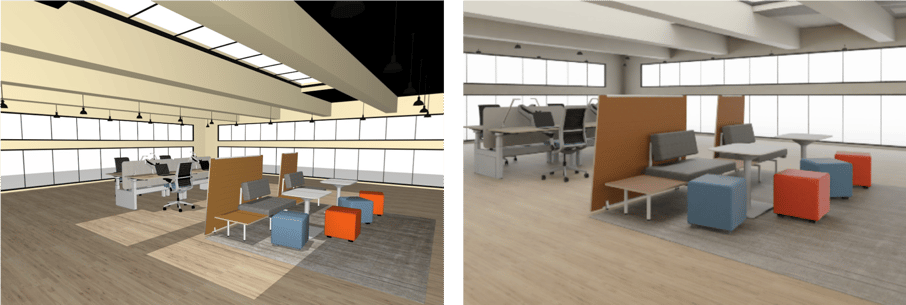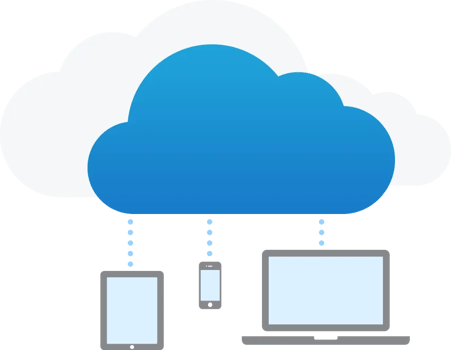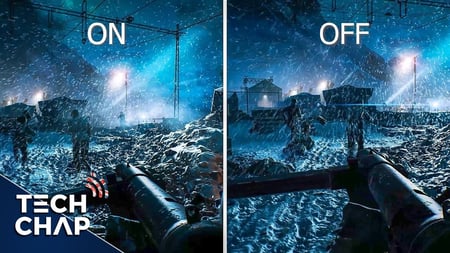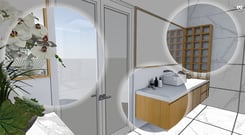2020 has already been an exciting year for all of us at Yulio. A few weeks ago, we released our brand new cloud-based rendering license called Yulio Jump, giving SketchUp and CET users a fast and simple way to create visually stunning images ready for VR.

This CET project was rendered with the native CET render feature (left) and Yulio Jump (right)
Over the years, we have learned and observed the many barriers designers face when rendering out projects. And while it would be ideal to produce visually stunning and photorealistic images for each project, sometimes there just isn’t enough time or resources available to do so.
The entire rendering process relies on a variety of variables. Depending on your PC’s processing power, how complex the model is and the type of quality you’re aiming for, rendering can take anywhere from 30 minutes to 4 hours. As a result, designers and project managers are constantly placed in a position to decide whether a project is worth the time investment for photorealism or not. Seeing this pain point was the inspiration and motivation behind Yulio Jump.
Before we dive into the benefits of cloud-based 3D rendering, let’s review what it actually is.
What is Cloud-Based 3D Rendering?
For those that have heard of “cloud” services but are unfamiliar with how it functions, it simply refers to services and software that use the Internet instead of your local computer. You may have heard of the various cloud storage options many smartphone companies have developed to help free up some space on your device. However, although the most well-known function for cloud-hosted services is storing and retrieving information like Google Drive or Dropbox, the cloud can also be used for processing data.

The "cloud" is a reference term for uploading your files onto servers that exist outside of your local device (image retrieved from: https://bit.ly/2R6LQ0O)
Cloud-based 3D rendering refers to the process of rendering your images using external servers rather than your local computer. All you have to do to use the service is to upload your 3D design onto a platform compatible with your CAD program of choice or a specific file format and let the servers get to work. One of the biggest advantages of a cloud-based rendering platform is the ability to transform your regular PC into a supercomputer. No longer will you need to wait hours for a single image to render. Now, you can cross the finishing line on your projects in a matter of minutes.
With that in mind, what are the top benefits of using a cloud-powered rendering platform?
1. Cut Down your Rendering Time
The most obvious and arguably most useful benefit of cloud-based 3D rendering is how quickly you can render your projects. All PC’s are limited by their RAM specifications and its processing power due to the nature of the device. And although there are various methods and shortcuts you can take to shave down the time to render, like opting for less photorealistic lighting or changing the textures, your computer operating at its max capacity will still take a substantial amount of time.
How cloud rendering differs from using your computer to render images is it takes advantage of parallel processing. Parallel processing, also known as parallel computing, refers to the method of computing and executing processes simultaneously. In layman's terms, cloud rendering is like combining the computing power of 10 computers to execute a task at the same time. Now applying this to rendering an image, uploading your project to a server allows you to execute the same task however harnessing the power of the 10 computers instead of just the one.

Take advantage of the computing power of rendering servers to help you finish your projects quicker
2. Free Up your Computer
Although rendering time is a huge pain point for many interior designers, the inability to use the computer for other tasks while the project is rendering is also a major inconvenience. Rendering is very intense and requires a large amount of processing power which most machines don’t have. So if there’s an upcoming project that needs a large high-quality rendered image, prepare to find something else to do while your computer is preoccupied.
The good news is that cloud rendering completely takes away this barrier since the project will be rendered on a server external to your local computer. So instead of using the computing power of one PC and waiting hours for your finished file, upload your project to a network of servers that exist purely to render images. Not only will you receive your image much quicker, but it also frees up your computer for other tasks. We understand that time is one of the biggest pain points for designers, and there never seems to be enough of it. With cloud rendering, start making the most out of your time at the office by completing any outstanding documentation or designing the next project while waiting for your finished image.

Sending your project out to the cloud frees up your computer, leaving you more time to start other tasks
3. Cost-Effective
While cloud rendering is not a free service, there are businesses that have great sign up offers or affordable yearly subscriptions. There are some businesses that charge based on how long it takes to render your project from their server - this could be per second or per hour. On the other hand, there are yearly subscriptions like our Yulio platform that will give you access to both our VR platform as well as cloud rendering capabilities. Not only does this plan come with unlimited rendering, but it also includes VR viewing capabilities - you can learn more by visiting our pricing page.
Although it does come with a price to use the platform, cloud-based 3D rendering is now incredibly affordable. Plus, the time that you save waiting for your finished image using your PC outweighs the low monetary investment.
4. Never Need to Settle for Less Quality
Both SketchUp and CET have a native renderer that comes with the CAD software. Since it’s included with the program itself, it’s a very convenient tool if you’re rendering rudimentary layouts for internal purposes. However, as it has become far more accessible and achievable to render high-quality images, businesses are now seeking photorealism.
The key to producing photorealistic images is the balance between shade and light. Mastering how light reflects off of a surface and the shadow it produces is what gives objects depth in a 2D image. It’s important to get this right especially when rendering images for visualization since it can really make or break the illusion of realism.
Different cloud rendering services will have their own methods for adding lighting finishes to the image. For Yulio Jump, we developed our own proprietary Ray-tracer for our platform to render projects with high-quality finishes and lighting. Ray-tracing is a rendering technique that tracks the path of light and simulate the effect on the objects in an image. To help you understand ray-tracing a little better, imagine shining a single laser on a cup - this would be one ray of light. While you can point the laser on one point, it provides no detail to the shape of the object. By uploading a project into a cloud renderer and taking full advantage of its enormous computing power, the Ray-tracer now has the ability to compute more paths of light to create a photorealistic image very quickly.

As you can see, using Ray-tracing technology, images become sharper and far more realistic (retrieved from: https://bit.ly/2QDAn9V)
Since cloud rendering simplifies the whole process and makes it far more efficient, designers and project leads will no longer need to cut corners or prioritize which images can be photorealistic. With a few clicks of a button, any and all projects can have advanced shading and lighting.
Rendering Made Easy
While rendering may have been one of the most inconvenient steps of the design process, it doesn’t have to be. Cloud-based 3D rendering has become incredibly affordable and can help you conclude projects in a much faster and simpler way. Plus, since the service does not require any training, designers will not need to restructure any part of their workflow. Experience speed and ease with rendering and begin harnessing the power cloud-based 3D rendering.
Yulio Jump for SketchUp and CET are now available for purchase on our pricing page! If you’re interested in seeing Yulio Jump and all of its capabilities for yourself, schedule a time to chat with our expert team. In the meantime, we have just entered into #JumpMonth where we’ll be sharing everything you need to know about cloud-based 3D rendering and Yulio Jump. Follow us on Facebook, Twitter or Linkedin!







